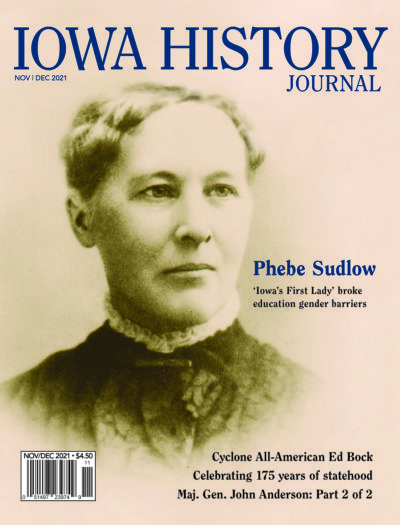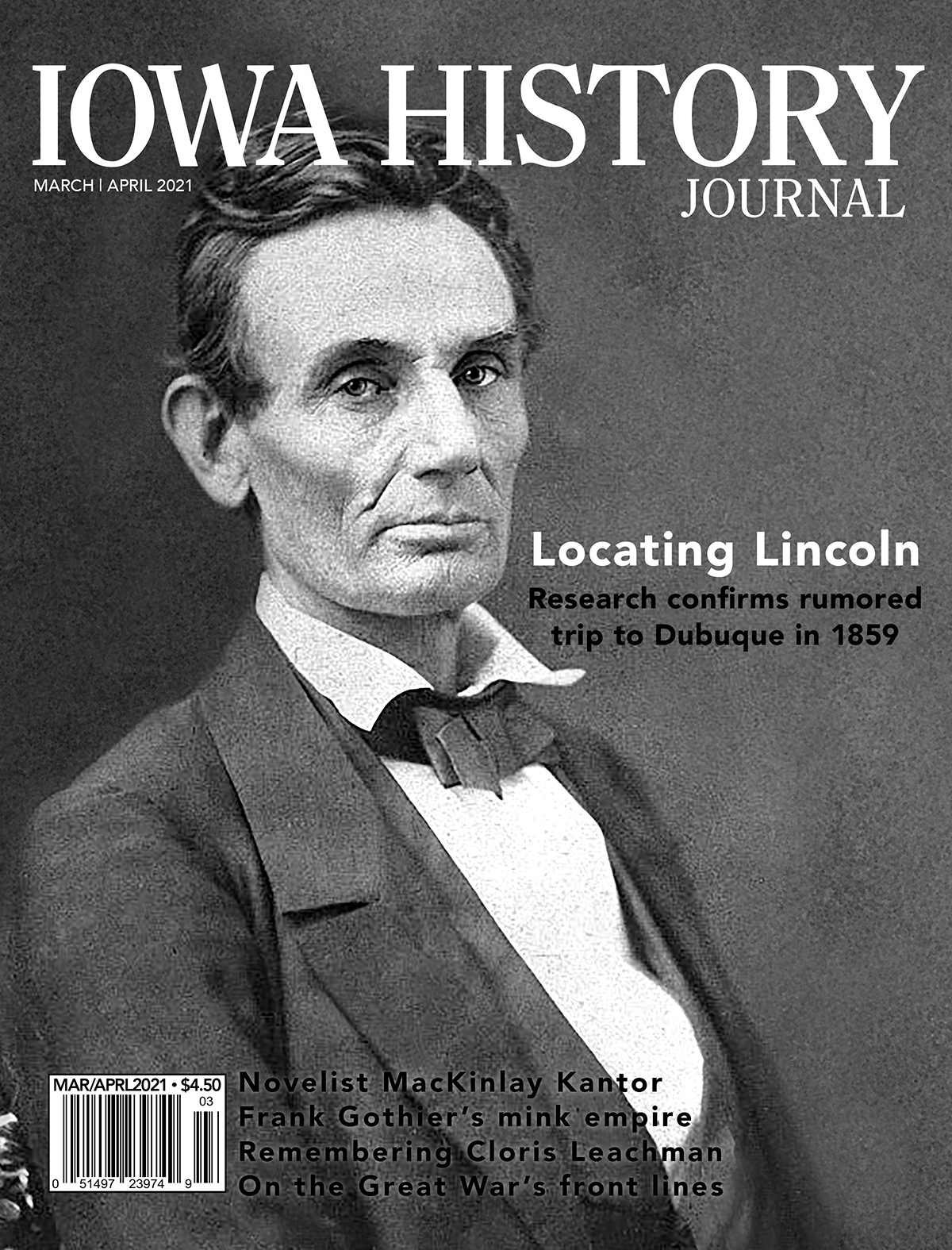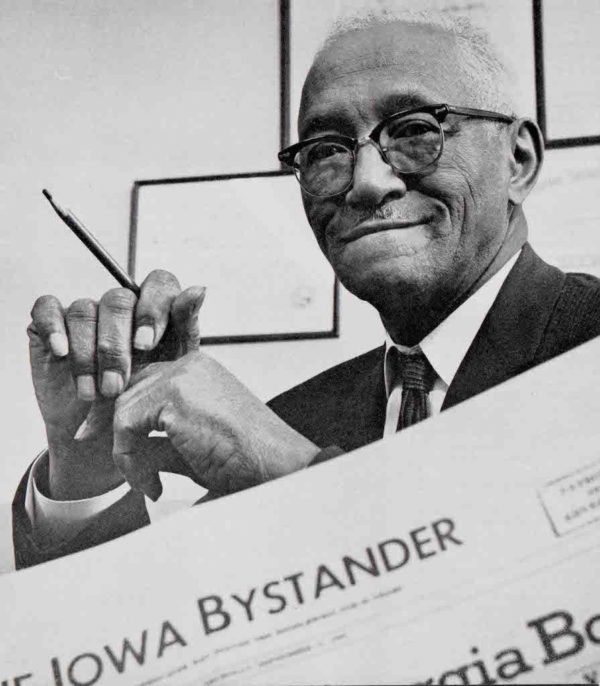
Photo of Phebe W. Sudlow published in “A History of Davenport’s Schools” by Mary A. Baker and a blog 2010 blog posted by the Davenport Public Library, “Equality through Education: Phebe W. Sudlow,” at blogs.deavenportlibrary.com. Photo courtesy of The Richardson-Sloane Special Collections Center of the Davenport Public Library
Volume 13, Issue No. 6, Nov/Dec 2021
Phebe W. Sudlow has appropriately been called “Iowa’s First Lady,” the first woman to hold significant titles in the field of education. In 1993, she was inducted into the Iowa Women’s Hall of Fame, recognizing her contributions to education and for women’s rights. By placing education — primary, secondary and post-secondary — at the center of her life, she enriched the lives of others by being forever a student and encouraging others to pick up that banner as well. Discover more about Sudlow and how she made history by improving Iowa’s educational system from award-winning writer Jerry Harrington.
Publisher Michael Swanger writes his “Publisher’s Perspective” column about how first-ballot National Baseball Hall of Fame member and legendary Chicago White Sox player Frank Thomas adds star power to the top of the lineup of ownership of All-Star Ballpark Heaven and the Field of Dreams Movie Site in Dyersville after it was announced that a venture led by Thomas purchased controlling interest of them.
Celebrate Iowa’s 175th anniversary of statehood with a story about the State Historical Museum of Iowa’s newest exhibit, “Iowa’s People and Places,” that marks milestones in Iowa’s history.
Get to know Ed Bock, the gritty All-American lineman who led the Cyclones’ 1938 famed football team and was Iowa State’s first member of the National Football Foundation Hall of Fame before becoming the President and CEO of the Monsanto Chemical Co. Longtime Quad City-Times sports editor and columnist Don Doxsie gives us the intriguing details.
Author Michael M. Van Ness concludes his two-part series about his grandfather, Maj. Gen. John B. Anderson, who was raised on an Iowa farm and later commanded the largest combat corps in World War II.
Learn what chatting with a stranger can mean from Iowa Country Roads columnist, Arvid Huisman and a big, big man… Bert the Dutchman.
Iowa Scrapbook columnist, Cheryl Mullenbach shares how Iowa farmers and Iowa State University worked together to conserve the state’s forests.
John Busbee, host of radio’s “The Culture Buzz,” reviews Joy Neal Kidney’s latest book, “Leora’s Dexter Stories.”
Read our tribute to Don Everly of the Everly Brothers (online only).

Maj. Gen. John B. Anderson (pictured in 1945) Photo courtesy of Michael M. Van Ness
Volume 13, Issue No. 5, Sept/Oct 2021
The story of Major General John B. Anderson, a Parkersburg farm boy who left his family to study at West Point, then rose through the ranks of the U.S. Army, reads like a military history of the 20th century. He chased Poncho Villa in Mexico, he led a battalion during World War I, he advised the U.S. State Department at the 1929 Geneva Convention and he commanded the largest U.S. combat corps during World War II. His grandson, author Michael M. Van Ness, shares Anderson’s compelling story in a two-part series that launches on the cover of our Sept/Oct issue.
Publisher Michael Swanger provides a personal account of his work as an Iowa newspaperman on 9/11 and his coverage of a Newton family whose patriarch was killed in the terrorist attacks in New York City on that tragic day.
Read about Reggie Roby and his booming leg that made him an iconic punter for the University of Iowa and an NFL All-Pro from Don Doxsie, a longtime sports editor and columnist.
Discover more about the life and times of Cedar Rapids native and popular television actor Don DeFore of “The Adventures of Ozzie and Harriet” and “Hazel” fame from Jeff Stein, author and News/Talk 1540 KXEL host.
Have you ever felt like you were out-of-order chronologically? Iowa Country Roadscolumnist, Arvid Huisman has. He shares how this has happened in other areas of his life and why.
Iowa Scrapbook columnist, Cheryl Mullenbach writes about Fort Madison State Penitentiary Warden James C. Sanders, the prison warden with a heart.
Author David Connon reviews Kenneth Lyftogt’s second volume of “Iowa and the Civil War.”
White Sox-Yankees game at Field of Dreams Movie Site promises to be heavenly and historic

Field of Dreams Movie Site where the Chicago White Sox and New York Yankees will play the first ever MLB game in Iowa on Aug. 12.
Thursday’s highly anticipated MLB game between the home team Chicago White Sox and visiting New York Yankees in Dyersville promises to be heavenly, especially for those who follow baseball religiously and who revere the magic of the iconic 1989 movie that will forever tug at heart strings.
The thought of a home run disappearing into the 159 acres of cornfields that surround the 8,000-seat stadium with its bullpens located behind a 12-foot wall that resembles old Comiskey Park is the stuff of dreams. The late author W.P. Kinsella, whose novel “Shoeless Joe” was the impetus for the movie “Field of Dreams,” and who earned a Master of Fine Arts in English at the Iowa Writers’ Workshop at the University of Iowa in 1978, likely could not have imagined it.
Read more about this historic event and discover IHJ Publisher Michael Swanger’s personal experience with Kinsella.

Orient Native and National Baseball Hall of Fame pitcher Dazzy Vance.
Volume 13, Issue No. 4, Jul/Aug 2021
From rural pastures to Major League Baseball’s stadiums, pitcher Dazzy Vance blazed his way into the National Baseball Hall of Fame with a legendary fastball that is still talked about today. Vance, a native of Orient, led the National League in strikeouts for seven consecutive years (1922-1928), threw a one-hitter and a no-hitter in consecutive starts in 1925, and was named the NL’s Most Valuable Player in 1924 when he won 28 games for the Brooklyn Dodgers. He won 197 games in his career, a remarkable feat considering he did not make it to the big leagues to stay until he was 31 years old. Vance was the first Dodger to be elected to the National Baseball Hall of Fame in 1955. John Skipper, retired newspaperman and author of “Dazzy Vance: A Biography of the Brooklyn Dodger Hall of Famer,” writes about Vance’s enthralling life on and off the field with the kind of expertise and depth that goes far beyond the statistics found on the back of Vance’s baseball cards.
Publisher Michael Swanger shares the results of the state’s Excellence in History and historic preservation awards.
Discover Frederick Douglass’ speeches in Dubuque and the photograph of the legendary orator that was taken there from researcher John T. Pregler
Take look amid the rolling hills at Keokuk National Cemetery. Don Doxsie explores the history of this stately display of studious simplicity and its connections to the Civil War.
Learn how an Iowa company lifted the curtain on small town spirits during the Great Depression by hosting theatrical productions across the state. Cheryl Tevis shares how her mom’s life intersected with the unlikely story of the largest live entertainment production company in the U.S.
It’s time for a summer road trip with Iowa Country Roads columnist, Arvid Huisman as he recalls the vacation road trips of his youth visiting relatives.
Iowa Scrapbook columnist, Cheryl Mullenbach writes about how well Iowa was represented at the St. Louis World’s Fair in 1904.

A portrait of legendary Hollywood cinematographer and former Iowan Bill Butler captured in January 1977 . Photo taken by and courtesy of Pamela Butler Fraser
Volume 13, Issue No. 3, May/Jun 2021
Picture this: The next time you watch iconic movies like “Jaws,” “Grease,” “Stripes,” “One Flew Over the Cuckoo’s Nest” and “Rocky” sequels II-IV, you are looking through the lens of legendary cinematographer and former Iowan Bill Butler. Renowned for his creativity, technical innovations and versatility, the 100-year-old Butler is among a handful of directors of photography who forever changed the way Hollywood movies were filmed starting in the 1960s working with directors such as Steven Spielberg, Francis Ford Coppola, Mike Nichols and Sylvester Stallone. Butler, who lived in Mount Pleasant and graduated from high school there in 1940, moved to Chicago, Ill., where he became a groundbreaking radio and television engineer, cameraman and documentarian for several years. In 1970, he moved to California and became a pioneer of the “New Hollywood” movement of the 1970s. In an exclusive interview with Iowa History Journal Publisher Michael Swanger, Butler spoke at length about his career, including behind-the-scenes stories about some of Hollywood’s most iconic movies.
Publisher Michael Swanger writes how lessons learned from pandemics bond the classes of 1921 and 2021.
Who is “the first baseball fan of the land?” Learn about Herbert Hoover’s love of baseballand how he attended more games than any U.S. president.
The in-depth, two-part series, “Locating Lincoln,” concludes and brings further light to Abraham Lincoln’s previously rumored trip to Dubuque in 1859.
Take a trip with Jeff Stein to Onawa where the century-old ice-cream treat formerly known as “Eskimo Pie” that was founded.
Jump right in for a ride with Iowa Country Roads columnist, Arvid Huisman as he drives down memory lane recalling when he spent the summer of 1962 washing cars as the 14-year-old founder of “Deluxe Car Wash.”
Iowa Scrapbook columnist, Cheryl Mullenbach remembers one of Iowa’s brightest women, Dr. Margaret Abigail Cleaves.

Image was taken by S.M. Fasset in October 1859 in Chicago. Photo courtesy of the Library of Congress
Volume 13, Issue No. 2, Mar/Apr 2021
For more than 150 years the legend in Dubuque long held that Abraham Lincoln visited Iowa’s oldest city in the 1850s, but no one knew when Lincoln was in Dubuque or why he traveled there with his wife, Mary Todd Lincoln. And so, the legend went. Historians have documented Lincoln’s three known trips to Iowa — Davenport (1857), Burlington (1858) and Council Bluffs (1859) — as well as the Illinois rail splitter’s other connections to the Hawkeye State, but it wasn’t until recently when Dubuque writer and researcher John T. Pregler unearthed evidence that Lincoln had indeed visited the “Key City to the Northwest” in 1859. Pregler’s cover story, “Locating Lincoln — Research confirms rumored trip to Dubuque in 1859,” is the first of his two-part series for Iowa History Journal which details Lincoln’s work as a corporate railroad lawyer and how the events of the 1850s led to Lincoln’s last significant legal case before going on to be elected President of the United States.
Publisher Michael Swanger devotes his column to retired newspaperman John Skipper’s latest book and ode to community newspapers, “No Time for Journalism, Boys — Just Type!”
Take a deeper look into the life of famous author MacKinlay Kantor and the great American Civil War novel, “Andersonville” with Timothy Walch, director emeritus of the Herbert Hoover Presidential Library
Did you know for much of the 20th century, the Iowa town of Anthon was the home of one of the world’s largest and most highly reputed mink ranches! Learn more about Frank Gothier, ‘Mister Mink’ and his mink empire in Anthon.
IHJ pays tribute to the late, legendary actress and Des Moines native Cloris Leachman.
No protective goggles needed when you join Iowa Country Roads columnist, Arvid Huismanas he recalls what he learned from his first BB gun, a lever-action J.C. Higgins.
Iowa Scrapbook columnist, Cheryl Mullenbach pays tribute to Helen Hayes Gleason who served on the front lines during the Great War.

James B. Morris Publisher The Bystander ca1961 Image courtesy of Joan Lifting-Zug Bourget Collection, State Historical Society of Iowa, Iowa City, Iowa
Jan/Feb 2021
Vol 13, Issue No. 1
James B. Morris Sr. was a battled-scarred World War I officer who returned home to Des Moines after the war to become one of only five practicing black lawyers in Iowa. He dabbled in politics and was a noted civil rights activist. He is best known as one of Iowa’s great 20th century journalists and the longtime owner and editor of the Iowa Bystander, one of the nation’s first commercial black newspapers published west of the Mississippi River. John Skipper, who retired after a 50-year newspaper career, tells the story of Morris’ perseverance and legacy in our cover story.
Publisher Michael Swanger pays tribute to Robert “Bob” Weast, the late jazz trumpeter and bandleader who founded the Drake University jazz program in 1969 and contributed several stories to Iowa History Journal over the years.
John Busbee writes a brief history of the prehistoric “sea lily,” the crinoid, and why it should be Iowa’s official fossil in his guest column.
Two University of Iowa professors journeyed to Alaska in 1951 to learn more about the elusive Spanish flu virus that killed an estimated 21 million people worldwide, including 6,000 people in Iowa, between 1918 and 1920.
Discover more about the Amish school crisis captured the world’s attention in 1965.
Explore the history of Northwest Iowa, the state’s last frontier.
Join Iowa Country Roads columnist, Arvid Huisman as he fondly remembers a country doctor who made house calls.
Iowa Scrapbook columnist, Cheryl Mullenbach writes about when the U.S. Army tested a new “automobile truck” in Dubuque in 1912 to possibly replace mules.
TO READ MORE FASCINATING STORIES ABOUT IOWA HISTORY, subscribe to Iowa History Journal. You can also purchase back issues at the store.
